ASRock Rack C2750D4I Review: A Storage Motherboard with Management
by Ian Cutress on April 29, 2014 9:00 AM EST- Posted in
- Motherboards
- Storage
- Atom
- ASRock
- Silvermont
- Enterprise
- server
- Avoton
Real World CPU Benchmarks
Readers of our motherboard review section will have noted the trend in modern motherboards to implement a form of MultiCore Enhancement / Acceleration / Turbo (read our report here) on their motherboards. This does several things – better benchmark results at stock settings (not entirely needed if overclocking is an end-user goal), at the expense of heat and temperature, but also gives in essence an automatic overclock which may be against what the user wants. Our testing methodology is ‘out-of-the-box’, with the latest public BIOS installed and XMP enabled, and thus subject to the whims of this feature. It is ultimately up to the motherboard manufacturer to take this risk – and manufacturers taking risks in the setup is something they do on every product (think C-state settings, USB priority, DPC Latency / monitoring priority, memory subtimings at JEDEC). Processor speed change is part of that risk which is clearly visible, and ultimately if no overclocking is planned, some motherboards will affect how fast that shiny new processor goes and can be an important factor in the purchase.
For reference, the C2750D4I does not implement any form of MultiCore Turbo.
Additionally, we are currently testing other 25W platforms that might provide more of an apt comparison against the Avoton CPU. These will come in a future review when testing is complete.
Rendering – Adobe After Effects CS6: link
Published by Adobe, After Effects is a digital motion graphics, visual effects and compositing software package used in the post-production process of filmmaking and television production. For our benchmark we downloaded a common scene in use on the AE forums for benchmarks and placed it under our own circumstances for a repeatable benchmark. We generate 152 frames of the scene and present the time to do so based purely on CPU calculations.
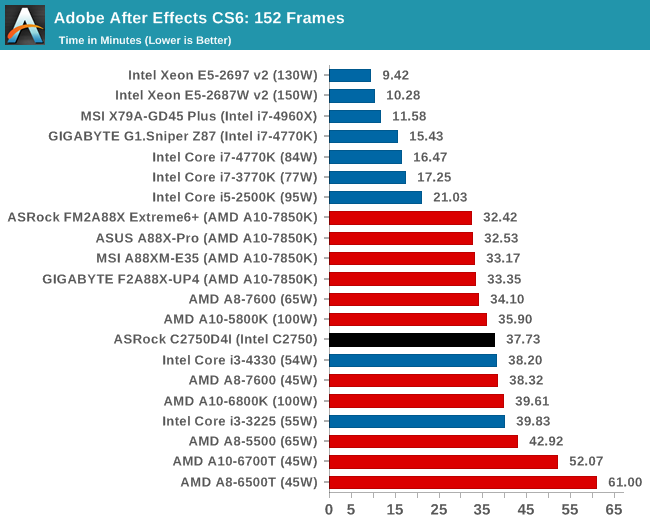
The full eight cores of the Avoton system gets to stretch its legs a little in our rendering test, easily putting it on par with the latest i3 CPUs and slightly behind the top end AMD APUs.
Compression – WinRAR 5.0.1: link
Our WinRAR test from 2013 is updated to the latest version of WinRAR at the start of 2014. We compress a set of 2867 files across 320 folders totaling 1.52 GB in size – 95% of these files are small typical website files, and the rest (90% of the size) are small 30 second 720p videos.
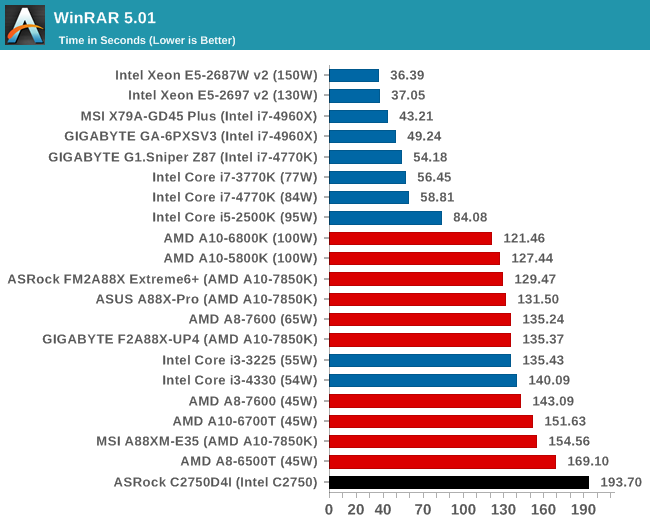
With a MHz deficit, the C2750D4I does not show much in the way of compression speed.
Image Manipulation – FastStone Image Viewer 4.9: link
Similarly to WinRAR, the FastStone test us updated for 2014 to the latest version. FastStone is the program I use to perform quick or bulk actions on images, such as resizing, adjusting for color and cropping. In our test we take a series of 170 images in various sizes and formats and convert them all into 640x480 .gif files, maintaining the aspect ratio. FastStone does not use multithreading for this test, and thus single threaded performance is often the winner.

Faststone is a purely singlethreaded benchmark, and the 2.6 GHz performance on Atom falls behind the main socketed platforms.
Video Conversion – Xilisoft Video Converter 7: link
The XVC test I normally do is updated to the full version of the software, and this time a different test as well. Here we take two different videos: a double UHD (3840x4320) clip of 10 minutes and a 640x266 DVD rip of a 2h20 film and convert both to iPod suitable formats. The reasoning here is simple – when frames are small enough to fit into memory, the algorithm has more chance to apply work between threads and process the video quicker. Results shown are in seconds and time taken to encode.
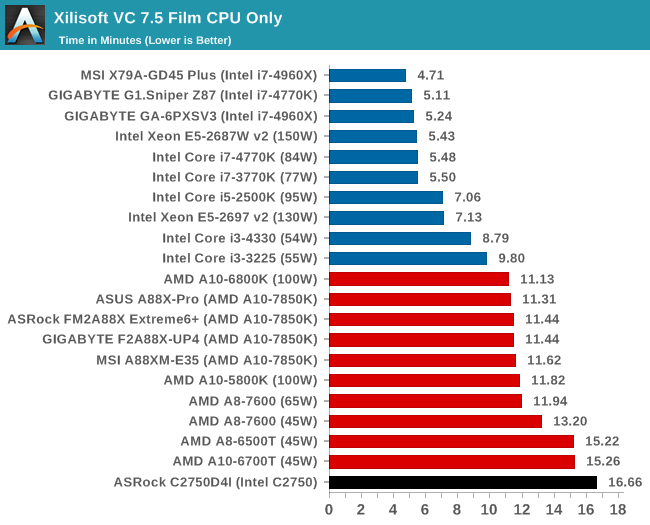
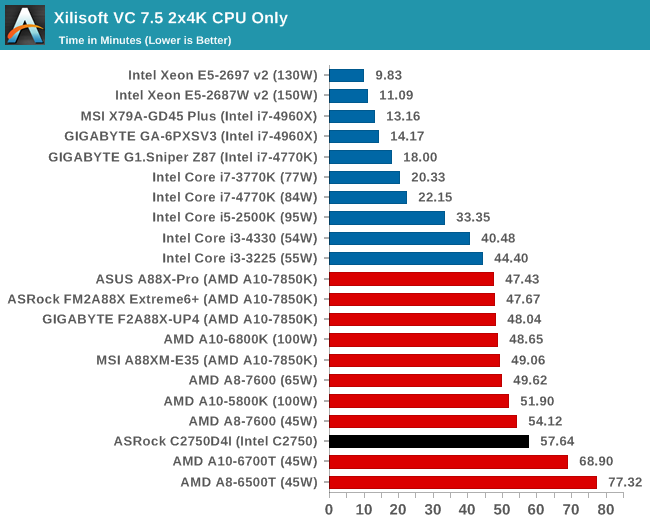
While the smaller frames cause the system to lag behind, the 4K video allows more cores to be put to better use.
Video Conversion – Handbrake v0.9.9: link
Handbrake is a media conversion tool that was initially designed to help DVD ISOs and Video CDs into more common video formats. The principle today is still the same, primarily as an output for H.264 + AAC/MP3 audio within an MKV container. In our test we use the same videos as in the Xilisoft test, and results are given in frames per second.
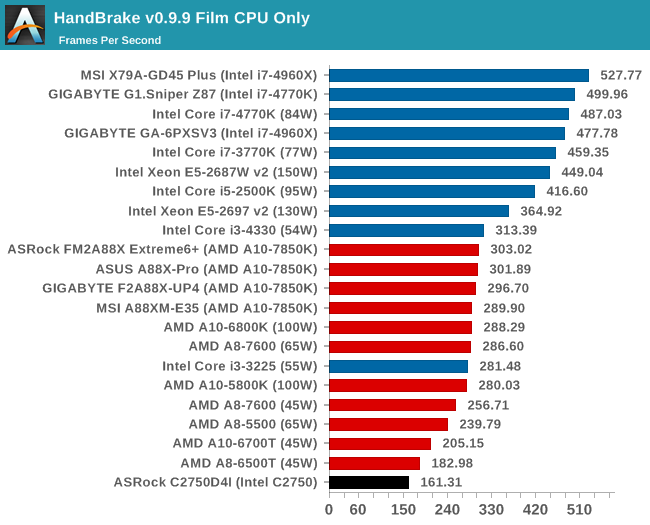
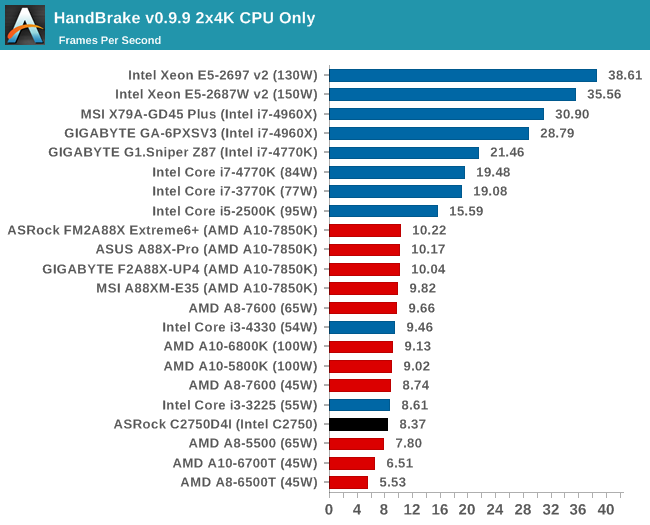
Similarly with HandBrake, the more cores benefit the higher resolution video conversion better.
Rendering – PovRay 3.7: link
The Persistence of Vision RayTracer, or PovRay, is a freeware package for as the name suggests, ray tracing. It is a pure renderer, rather than modeling software, but the latest beta version contains a handy benchmark for stressing all processing threads on a platform. We have been using this test in motherboard reviews to test memory stability at various CPU speeds to good effect – if it passes the test, the IMC in the CPU is stable for a given CPU speed. As a CPU test, it runs for approximately 2-3 minutes on high end platforms.
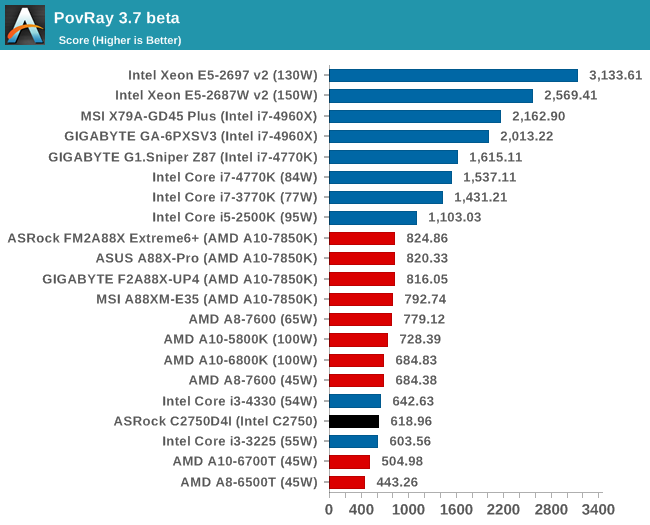










85 Comments
View All Comments
chekk - Tuesday, April 29, 2014 - link
Yes, for that price and target market, they should have gone with an LSI chip. You don't see Supermicro or Tyan boards in that price range using Marvell.cen - Tuesday, April 29, 2014 - link
I know it was said that the actual storage review is coming in the future but I think this article is a complete waste of time. You should simply let the storage review happen and not bother with this at all. More than half of the benchmarks are useless, the only ones of value might be encryption and compression.What we actually want to see is FreeNAS thrown in there with a 16TB ZFS zpool and some IO benchmarks. :)
Calista - Tuesday, April 29, 2014 - link
Could be perfect for anyone wishing to build a tiny box for virtualization, a task in which many a NIC, plenty of RAM and a multicore processor is most helpful.RandomUsername3245 - Tuesday, April 29, 2014 - link
I've wondered how one of these Avoton boards would compare to a Supermicro C2xx + Pentum G3430 (which supports ECC). This is the cheaper option if you don't need lots of ports, but once you add $100 for a sata card from Ebay, these options are similarly priced.Calista - Tuesday, April 29, 2014 - link
Could you please measure power consumption without the 770 as well? I have a HP Elite 8200 with a quad i5, SSD + 2.5" HDD, 32 GB RAM and an extra NIC as a makeshift box for ESXi and with 6-8 virtual machines running it draw less than 30 watt. It would be interesting to know how low this machine could go since any machine running 24/7 will add substantially to the power bill.Guspaz - Tuesday, April 29, 2014 - link
If I was using this in my home file server, I'd make a few changes to the board. The number of SATA ports is fine, because even though I've got 18 drives in mine, that PCIe slot lets you put in a SAS/SATA controller to get the total up as high as needed (16 port cards aren't hard to find, higher is available).However, I'd change a few things:
1) Replace the CPU. Home file servers can often be bottlenecked by individual CPU core performance, because not all filesystem operations on ZFS are multithreaded (although it's far better these days). For the ~25W TDP, I would much rather have a Haswell part, even if it meant fewer cores. For that TDP, you could get a ~3GHz dual-core part, or a ~2GHz quad-core part. Either of those would be better suited.
2) Add digital video output. HDMI, DVI, DisplayPort, any of them. I'm not suggesting using this thing for HTPC use, but many monitors these days are digital-only, and nothing is more annoying than trying to diagnose problems with a headless system when your motherboard is VGA-only and all you have is digital-only monitors.
3) Drop two of the RAM slots, and use them for another PCIe slot. Four slots is excessive for anything but enterprise use. Two slots cheaply gets you 16GB of RAM, or 32GB if you're desperate, either of which is more than enough for a home file server. A second PCIe slot, on the other hand, could enable a variety of other options, be they multiple SAS/SATA cards, a discrete video card if you really do want to use the thing as an HTPC, a video capture card (this board in that Silverstone case would probably make a decent HD-SDI recording box), etc.
4) More USB ports, prefereably 3.0. If extra space is needed for the ports, ditch one of the three GigE ports; two is plenty.
5) An mSATA slot for a boot drive could be useful, although it would probably increase board complexity by requiring some of the board components to move to the rear.
stoatwblr - Thursday, May 1, 2014 - link
"Two slots cheaply gets you 16GB of RAM, or 32GB if you're desperate"My ZFS media rig has 19 drives (21 including the ZIL and l2arc), plus boot media and at 36Tb it _needs_ 32Gb of ram to work efficiently. It kept bottlenecking at 16Gb. The next round of storage will push well past the 32Gb requirement.
+1 on the video output, +1 on usb3 - but I don't think it needs more ports. That's not a good fit for the target, which is a storage controller. Ditto on the mSATA.
If you need fewer cores there's a quad-core version which is cheaper.
I'd prefer that they placed a lsi sas controller onboard and dumped the sata ports for minisas (an expander cable is cheap, tidy and positively locks into place to ensure no problems.) The downside is that a decent sas controller would add at least $100 and a port multiplexer as much again.
If I was designing, I'd think about 10Gb copper, but that adds 15W to the power consumption and $150 to the price.
This thing is expensive for prosumers and limited for enterprise, but compromises are always like that. Supermicro's version has similar issues and the fact that they don't use minisas makes me think that perhaps Intel have placed restrictions on what can be used.
bernstein - Thursday, May 1, 2014 - link
well my zfs rig has 20 2.5" 2tb sata hdds (2x 16tb raidz2). no ZIL. no L2ARC.runs on a single 8GB ecc ddr2 dimm on a sandy bridge i3-2100T.
as a home fileserver this system rocks. it might be ram "bottlenecked" for high i/o tasks, but all i can see is that it performs at least as well as a single USB3 hdd... and it outperforms any consumer nas.
Daniel Egger - Tuesday, April 29, 2014 - link
For a NAS or SAN build this seriously lacks 10GbE and USB 3 ports. All in all this board seems like a pretty strange amalgamation of random features, as there're better choices for about any possible use case around.Gunbuster - Tuesday, April 29, 2014 - link
14000 RPM Delta fans? No Thanks!I would have called it the AssRack. Sorry I couldn't resist!